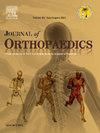Clinical and functional outcomes of reverse total shoulder arthroplasty for proximal humerus fracture versus rotator cuff arthropathy: A retrospective analysis
IF 1.5
Q3 ORTHOPEDICS
引用次数: 0
Abstract
Introduction
The utility of reverse total shoulder arthroplasty (RTSA) has evolved to accommodate many complex shoulder pathologies including proximal humerus fractures (PHFs) and fracture sequelae. Within our aging population, PHFs are occurring at higher rates than ever before. Literature assessing differences in clinical and functional following RTSA for PHF and rotator cuff arthropathy (RCA) is limited. This study aims examine outcomes after RTSA for PHF and RCA at 2-years follow-up.
Methods
Records of who underwent RTSA for PHF and RCA at our institution between July 1, 2009 to October 1, 2019 with a 2-year minimum follow-up were retrospectively analyzed. Patient demographic information, postoperative functional measurements, and complications were collected. A 5-year Kaplan-Meier survival analysis was performed.
Results
Overall, 23 patients underwent RTSA for fracture and 123 for RCA. Fracture patients showed significantly worse forward elevation (128.9° ± 38.8° vs 141.9° ± 21.1°; p-value = 0.0242). No differences were observed in range of motion or strength for external rotation and internal rotation, as well as patient-reported outcome measures. Fracture patients showed a complication rate of 9.1 % and an implant survival rate of 78.0 % after 5 years. RCA patients experienced a 7.4 % complication rate and a 91.5 % survival rate after 5 years.
Discussion
RTSA has been shown to restore shoulder functionality in patients with complex PHFs. In this study, RTSA for fracture resulted in similar functionality, complication rates, and implant longevity when compared to elective indications.
反向全肩关节置换术治疗肱骨近端骨折与肩袖关节病的临床和功能结果:回顾性分析
反向全肩关节置换术(RTSA)的应用已经发展到适应许多复杂的肩关节病变,包括肱骨近端骨折(phf)和骨折后遗症。在我们老龄化的人口中,ph的发生率比以往任何时候都高。评价RTSA治疗PHF和肩袖关节病(RCA)后临床和功能差异的文献有限。本研究的目的是在2年的随访中检查RTSA治疗PHF和RCA的结果。方法回顾性分析我院2009年7月1日至2019年10月1日期间因PHF和RCA接受RTSA治疗的患者,随访时间至少为2年。收集患者人口统计信息、术后功能测量和并发症。进行5年Kaplan-Meier生存分析。结果23例骨折行RTSA治疗,123例RCA治疗。骨折患者的前抬高幅度明显较差(128.9°±38.8°vs 141.9°±21.1°);p值= 0.0242)。外旋和内旋的活动范围或力量以及患者报告的结果测量没有观察到差异。骨折患者5年后并发症发生率为9.1%,植入物存活率为78.0%。RCA患者的并发症发生率为7.4%,5年后生存率为91.5%。rtsa已被证明可以恢复复杂phf患者的肩部功能。在本研究中,与选择性指征相比,RTSA治疗骨折的功能、并发症发生率和植入物寿命相似。
本文章由计算机程序翻译,如有差异,请以英文原文为准。
求助全文
约1分钟内获得全文
求助全文
来源期刊

Journal of orthopaedics
ORTHOPEDICS-
CiteScore
3.50
自引率
6.70%
发文量
202
审稿时长
56 days
期刊介绍:
Journal of Orthopaedics aims to be a leading journal in orthopaedics and contribute towards the improvement of quality of orthopedic health care. The journal publishes original research work and review articles related to different aspects of orthopaedics including Arthroplasty, Arthroscopy, Sports Medicine, Trauma, Spine and Spinal deformities, Pediatric orthopaedics, limb reconstruction procedures, hand surgery, and orthopaedic oncology. It also publishes articles on continuing education, health-related information, case reports and letters to the editor. It is requested to note that the journal has an international readership and all submissions should be aimed at specifying something about the setting in which the work was conducted. Authors must also provide any specific reasons for the research and also provide an elaborate description of the results.
 求助内容:
求助内容: 应助结果提醒方式:
应助结果提醒方式:


